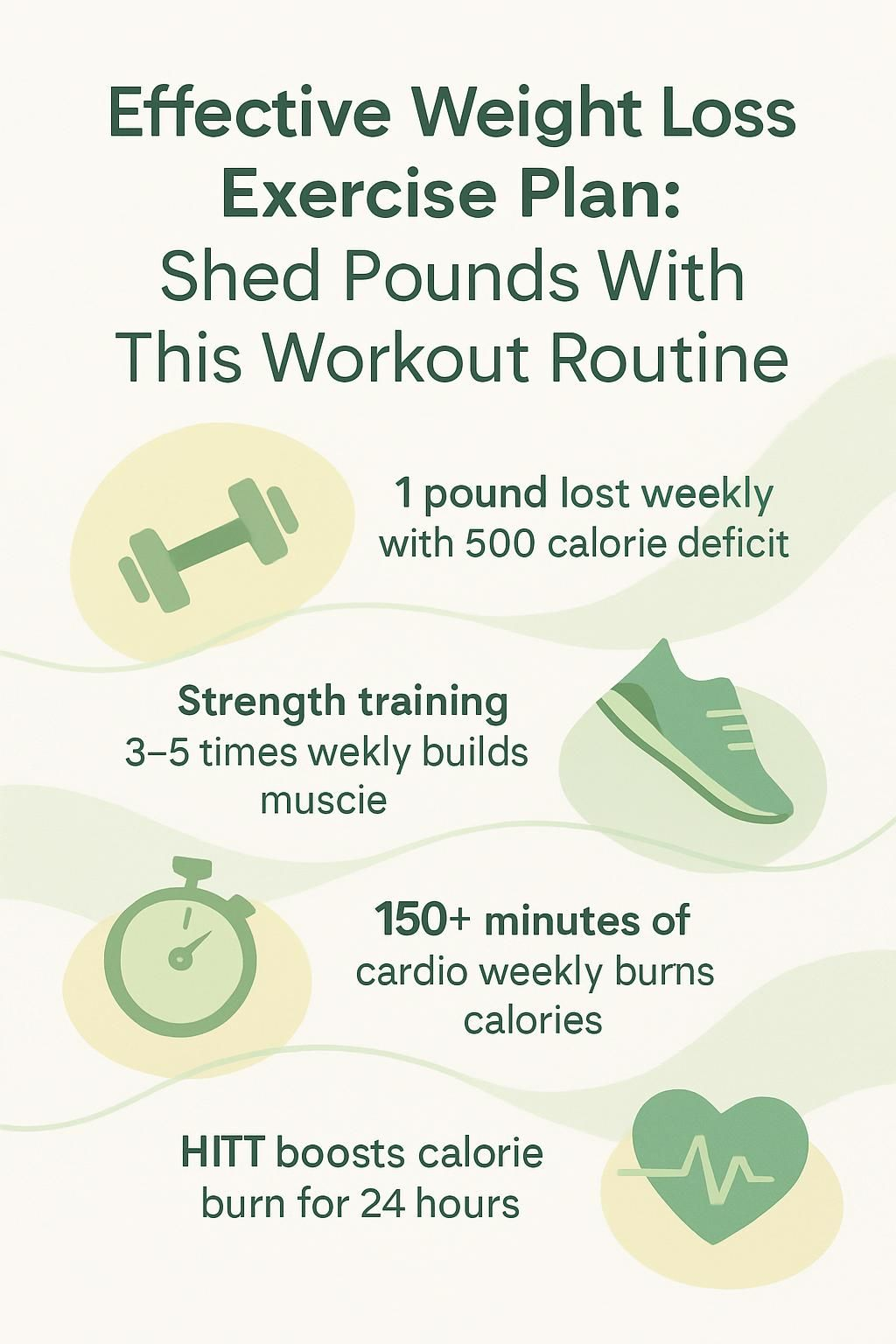Effective Weight Loss Exercise Plan: Shed Pounds With This Workout Routine
Our Nutrition Assistant AI Suite will transform your body. You will lose fat, get toned, and build muscle. Gain confidence and optimal health.
If slow progress has you discouraged, you are not alone. A clear workout plan makes weight loss simpler and more predictable. Research shows that a balanced exercise plan with cardio and strength training helps you burn more calories and keep weight off.
Use the steps below to start strong. Small changes stack up fast. Put one week together, then build from there.
Key Takeaways
- Blend cardio, strength training, and active recovery inside one weekly plan. Aim for a 500-calorie daily deficit for about 1 pound per week.
- Lift weights three to five days weekly to build muscle, which raises your resting metabolic rate.
- Use HIIT, short bursts of hard effort, to increase calorie burn for hours after you finish.
- Log at least 150 minutes of moderate cardio per week. Activities like brisk walking or cycling can burn roughly 200 to 600 calories per hour.
- Track more than the scale. Body composition tools, such as the Evolt 360, show body fat, muscle mass, and other markers that guide your plan.

Understanding Weight Loss Fundamentals

Weight loss happens when you burn more calories than you eat. A well planned workout raises your daily calorie burn and supports long-term weight management.
How does weight loss actually work?
Weight loss requires a calorie deficit. You create one by eating a bit less, moving more, or both. Sports medicine experts put it simply: Energy out must be greater than energy in.
Basal Metabolic Rate, or BMR, is the calories your body uses at rest. For example, a 30-year-old woman who is 56 inches tall and weighs 150 pounds has a BMR near 1,417 calories per day.
Total Daily Energy Expenditure, or TDEE, multiplies your BMR by your activity level. Common multipliers include 1.2 for sedentary, 1.375 for lightly active, 1.55 for moderately active, and 1.725 for very active. If she is moderately active, her TDEE is about 2,196 calories. Eating below that, or moving more, creates the deficit that leads to fat loss.
Regular exercise, both aerobic activity and strength training, boosts energy output. It also helps protect muscle, which keeps your metabolism higher over time.
What is the difference between fat loss and weight loss?
Fat loss means reducing body fat. Weight loss includes changes in fat, water, and sometimes muscle or bone. Early drops on the scale often come from water, not fat.
If you chase quick weight loss without strength training or adequate protein, you may lose muscle. That slows your metabolism and can raise health risks. Focus on burning fat while you protect lean muscle with lifting and smart eating. Spot reduction is a myth. You cannot force fat loss from one area with a single move. Your body decides where fat comes off first.
How does exercise contribute to weight loss?
Exercise increases how many calories you burn each day. Brisk walking can use about 200 to 300 calories per hour. Running can reach 600 calories per hour, depending on your weight and pace.
Strength training grows muscle, which raises your resting burn. High-intensity interval training, called HIIT, creates an afterburn effect. Your metabolism stays elevated for hours as you recover. Lower-impact options like cycling and swimming keep you active on in-between days and support recovery.
Key Components of an Effective Weight Loss Exercise Plan
You will see the best results when you pair different training methods. This mix fights boredom, builds fitness, and helps you stay consistent.
Cardio exercises
Cardio helps you burn calories and supports heart health. Start with low to moderate intensity sessions like brisk walking, jogging, cycling, or swimming.
- Even 20 minutes can help if you stay consistent.
- Brisk walking for 30 minutes burns about 150 calories for many adults. Jogging can reach 250 to 300.
- Sneak in movement. Take the stairs, walk during calls, or bike to work if you can.
Cardio also lowers stress and supports healthy blood pressure. It pairs well with strength training for fat loss.
Strength training
Strength training builds lean muscle, which increases your resting metabolic rate. Train both upper and lower body. Aim for three to five sessions per week with at least one day between hard lifts for recovery.
- Start light and increase weight slowly. The last reps should feel hard but safe.
- Use big compound moves like squats, lunges, push-ups, rows, and presses. These hit large muscle groups and burn more calories.
- Track your sets, reps, and loads in an exercise journal. Progress you can see builds motivation.
Weight training helps preserve bone health while you lose fat. It also supports your energy for cardio and intervals.
Flexibility and recovery
Flexibility work and recovery days prevent overuse injuries and reduce soreness. They keep your body moving well as training volume climbs.
- Add dynamic stretching, yoga, or easy swimming after hard days.
- Active recovery, like a long walk, improves blood flow without added strain.
- Planned rest can cut sports injuries by a large margin. Many people feel less sore when they keep light movement on rest days.
These pieces support your cardio and lifting so you can train hard without burnout.
How Do I Set Realistic Weight Loss Goals?
Clear goals keep you focused and reduce frustration. Pick targets that match your lifestyle and timeline.
What is a healthy weight loss target?
Most experts suggest about 1 pound per week. A daily deficit near 500 calories often achieves that pace. Faster rates raise the risk of muscle loss, low energy, and rebound weight gain.
Even modest progress improves health markers like blood pressure and blood sugar. The Centers for Disease Control and Prevention supports a slow, steady approach because it is more likely to last.
How can I track my progress effectively?
Use a body composition scanner if you have access, such as the Evolt 360 at some gyms. It reports fat mass, muscle mass, visceral fat, body fat percentage, and biological age.
These numbers reveal more than the scale. A drop in fat with a rise in muscle shows your plan is on track. Log workouts and scans in a simple app. Adjust your meal plan and exercise based on the data you see, not guesses.
During weeks when the scale barely moved, seeing body fat drop kept me locked in. Build that feedback into your plan.
Weekly Structure of a Weight Loss Workout Plan
A simple weekly setup helps you stick with your program. Think of it like a calendar for your results.
Balancing cardio, strength, and rest days
- Schedule at least 150 minutes of moderate cardio each week. Try brisk walking, cycling, or swimming.
- Include two or more strength sessions. Use bodyweight, machines, or free weights.
- Plan rest or active recovery days. Gentle stretching and yoga reduce injury risk.
- Rotate training types to stay fresh. Alternate cardio, upper body, lower body, HIIT, and outdoor sessions.
- Track your workouts and sleep. Good sleep supports recovery and weight control.
- Keep your schedule flexible. Fit training around work, family, and energy levels.
- Hydrate before, during, and after training. Fluids support performance and recovery.
Example weekly schedule
Use this sample to combine fat loss and muscle building. Adjust times and exercises to your needs.
- Day 1: Do 30 minutes of cardio like walking, jogging, swimming, or dancing. Keep a steady pace.
- Day 2: Strength train. Perform 3 sets of 10 to 12 squats and 3 sets of 10 to 12 lunges per leg. Add push-ups and rows for balance.
- Day 3: Active rest for 30 minutes, such as yoga or easy stretching.
- Day 4: Complete a 30-minute HIIT session. Use simple moves like burpees or sprints.
- Day 5: Upper body strength. Bench press and overhead press for 3 sets of 10 to 12. Add rows for 3 sets of 10 to 12.
- Day 6: Full rest. Let your muscles repair and rebuild.
- Day 7: Spend 30 minutes hiking or biking outdoors to cap the week.
This mix of cardio, strength, mobility, recovery, and rest makes your workout plan sustainable. Pair it with a healthy eating plan for better results.
4-Week Weight Loss Workout Plan
This four-week plan builds habits first, then intensity. Each week nudges your fitness forward.
Week 1: Building a foundation
- Day 1 lower body: 3 sets of 12 goblet squats, 3 sets of 12 Romanian deadlifts, and 3 sets of 20 walking lunges. Add leg curls or extensions if needed.
- Day 3 upper body: 3 sets of 12 lat pulldowns or assisted pull-ups, overhead presses, dumbbell rows, and bench presses. Add curls or triceps extensions if you have time.
- Day 5 conditioning: Do 15 seconds of hard work, then 15 seconds of rest. Complete three rounds.
- Use active rest between lift days to support recovery. Gentle walks and light stretching work well.
- Track sets, reps, and weights from day one. You will see progress faster on paper.
- Drink water through the day to support training and appetite control.
- Plan meals with protein, whole grains, fruits, and vegetables. Balanced fuel helps recovery and performance.
- Sleep 8 hours if possible. Better sleep supports fat loss.
Week 2: Increasing intensity
- Raise cardio duration or pace by 5 to 10 percent.
- Add a warm-up set before major lifts to prep muscles and joints.
- Increase load so the last two reps of each set feel challenging.
- Do one HIIT workout this week. Try 30 seconds fast and 60 seconds easy for several rounds.
- Push your conditioning to four rounds with short rests.
- Keep tracking your performance to confirm progress.
- Stretch after every session to maintain range of motion.
Small bumps in effort often lead to quick wins in week two.
Week 3: Adding variety
- Change your cardio mode. Switch from treadmill to bike or swim. Add 5 to 10 percent to intensity or time.
- Lower reps to eight per set and lift heavier weights with strict form.
- Use barbell versions of key moves when safe, such as squats and bench presses.
- Complete two HIIT sessions this week, five intervals each.
- Add yoga or dynamic stretching after tough days.
- Include one outdoor cardio session for a mental boost.
- Check your protein target and calorie range with a food log.
Week 4: Maximizing results
- Increase lifting weights by 5 to 10 percent if form allows.
- Keep cardio at a higher intensity, near 70 to 85 percent of your max heart rate.
- Expand conditioning to six rounds with brief rests.
- Follow the week three structure, but fine-tune based on how you feel.
- Watch portions and hydration closely. Both drive recovery and muscle retention.
- Prioritize 7 or more hours of sleep. Good sleep improves weight control.
- Do short daily flexibility work to manage soreness.
- Reward small wins with non-food treats, such as new music or gear.
Next, use the sample daily workouts for clear guidance.
Sample Daily Workouts
Daily structure reduces guesswork. These examples keep you moving and on track.
What cardio exercises should I do on Day 1?
Day 1 starts with cardio to boost calorie burn and warm up your week.
- Walk briskly for at least 20 minutes. The CDC outlines adult activity goals here: https://www.cdc.gov/physicalactivity/basics/adults/index.htm.
- Jog or run outdoors or on a treadmill. Many adults burn about 100 calories per mile.
- Swim laps for a joint friendly, full body session.
- Cycle indoors or outside. Moderate cycling for 30 minutes can burn about 250 to 500 calories.
- Use an elliptical trainer for low impact work.
- Train for at least 20 minutes at a steady pace that lets you speak in short sentences.
How do I perform upper body strength training on Day 2?
Focus on major upper body muscles to build strength and support fat loss.
- Warm up for 5 to 10 minutes with arm circles or light rowing.
- Do 3 sets of 12 pull-ups, or use a lat pulldown machine if needed.
- Press dumbbells overhead for 3 sets of 12 with control.
- Row dumbbells for 3 sets of 12 per arm with a flat back.
- Bench press dumbbells for 3 sets of 12 on a flat bench.
- Add curls or triceps extensions for 3 sets of 12 if time allows.
- Rest at least one minute between sets and hydrate.
- Log weights and reps so you can progress next week.
- Cool down with five minutes of easy stretching for chest, shoulders, arms, and back.
This structure hits multiple muscle groups and supports your weight loss workout plan.
What are good active rest activities for Day 3?
Active rest improves recovery without draining your energy.
- Take a brisk walk at a park or on a quiet street.
- Try a short yoga flow to ease soreness and reduce stress.
- Swim at an easy pace for 20 to 30 minutes.
- Use dynamic stretches such as leg swings, hip circles, and arm sweeps.
- Climb at an indoor wall if available. Keep it light.
- Spin a bike at a relaxed pace for 20 to 30 minutes.
- Choose light rowing or a gentle elliptical session if you prefer machines.
These activities keep you moving while your body heals.
How is High-Intensity Interval Training (HIIT) done on Day 4?
HIIT uses short, hard bursts followed by brief rests. It raises calorie burn during and after the session.
- Warm up for 5 minutes with fast walking or easy jogging.
- Pick one move, like sprints, cycling, jumping jacks, or mountain climbers.
- Go hard for 15 seconds at near maximum effort.
- Recover for 15 seconds with light movement.
- Repeat for at least 3 rounds if you are new. Work up to 6 rounds as fitness improves.
- Keep form sharp to lower injury risk.
- Cool down with 5 minutes of easy walking and deep breathing.
- Drink water before, during, and after intervals.
- Use a timer or app to manage work and rest times.
- Limit HIIT to once per week at first. Your muscles need time to adapt.
Consistent HIIT can improve fitness quickly while supporting fat loss.
What strength training exercises target the lower body on Day 5?
Strong legs drive daily movement and raise your total calorie burn.
- Goblet squat, 3 sets of 12. Targets quads, glutes, and core.
- Deadlift, 3 sets of 12 with moderate weight. Trains hamstrings, glutes, and lower back.
- Walking lunges, 3 sets of 20 steps. Builds balance and leg strength.
- Optional: Leg curls or leg extensions, 3 sets of 12.
- Log every set and rep. Steady tracking leads to steady gains.
- Use controlled form on each rep to stay safe and get full benefit.
Compound lifts like squats and deadlifts train many muscles at once, which boosts total energy use.
Why is rest and recovery important on Day 6?
Rest is where your body repairs. Skipping it often slows progress.
- Muscles rebuild stronger during downtime between hard sessions.
- Rest days lower the risk of overtraining and nagging injuries.
- Quality sleep helps regulate appetite hormones, which supports a healthy eating plan.
- Adults generally need 7 to 9 hours of sleep for best recovery.
- Lower stress improves fat metabolism and mood.
- Drink plenty of water to support cell repair.
- Try light stretching to increase blood flow without strain.
- Watch for fatigue signs so you can adjust before burnout hits.
What outdoor cardio activities are recommended for Day 7?
Training outside can boost your mood and your step count.
- Hike a local trail for 45 to 60 minutes. Many people burn 430 to 480 calories per hour at a brisk pace.
- Climb stadium or park stairs. Short stair sessions add up over time.
- Join a jogging group or run laps at a park. Outdoor runs often feel more engaging.
- Ride a bike on a bike path. Thirty minutes at a moderate pace can burn 200 to 300 calories.
- Use interval walking. Alternate fast and easy segments to increase fat burn.
- Play casual sports like basketball, soccer, or frisbee with friends.
One month of Sunday hikes with friends lifted my mood and improved my endurance. Find a rhythm that fits your life.
How Can I Stay Motivated and Consistent?
Motivation rises when you enjoy the process. Consistency comes from simple systems and small wins.
How do I find activities I enjoy?
Test different formats. Try a group class, a swim day, a lifting session, or a short run. People who rotate styles often report greater enjoyment and better adherence.
You might choose swimming twice a week and two days of strength training. I joined a local running club after months of solo lifting. The group energy made outdoor runs fun and kept my goals clear.
What are good ways to reward my progress?
Pick rewards that fuel your plan. Buy a comfortable pair of shoes, new resistance bands, or a water bottle you will use daily. Plan an active outing with friends to celebrate a milestone.
Track non-scale wins like better sleep, improved flexibility, or more energy. Positive reinforcement supports long-term success.
How can I effectively track my workouts?
Use a training journal or app. Log exercise type, time, sets, reps, and weights. Many free tools show trends with simple charts.
Wear a fitness tracker if you have one. It can monitor heart rate and estimate calories during cardio. For deeper detail, a body composition scan such as the Evolt 360 can show fat and muscle changes over time. Seeing strength numbers rise week by week kept me consistent.
Tracking keeps you accountable and focused on progress, not just the scale.
Combining Diet and Exercise for Maximum Results
Exercise and nutrition work better together. Pair a smart workout plan for weight loss with a realistic eating plan for steady fat loss.
Why is proper nutrition important?
To lose fat, you need a calorie deficit relative to your TDEE, which is your daily burn from living and moving. Exercise helps, but eating above your burn will stall results.
Diet often has the biggest impact on early changes. Balanced meals with enough protein help you protect muscle while you lose weight. Consistent tracking of food and training gives a clear picture of habits to keep or change.
What are the best hydration tips?
Hydration supports energy, training quality, and recovery. Aim for about eight 8-ounce glasses of water daily, more if you sweat heavily.
- Carry a reusable bottle and sip through the day.
- Drink before, during, and after workouts.
- Choose water most of the time. Save sports drinks for long, intense sessions.
- Use urine color as a guide. Pale yellow usually means you are hydrated.
Staying hydrated improves exercise performance, according to public health guidance.
How should I plan meals to complement workouts?
Build meals around lean protein, complex carbs like oats or brown rice, colorful vegetables, and healthy fats. Eating a mix of protein and carbs within two hours after hard training supports recovery.
Meal prep can make this easier. I prepped chicken and sweet potatoes for post-workout dinners and felt less sore the next day. Use a food scale or an app to manage portions and stay within your calorie target. People who plan meals tend to lose fat more steadily.
Common Mistakes to Avoid During Weight Loss Exercise
A few common errors slow results. Avoid them to protect your progress and your health.
What are the risks of overtraining?
Overtraining can lead to chronic soreness, poor sleep, and injuries like strains or stress fractures. Performance drops and motivation fades. Rest days and deload weeks reduce these risks and keep you moving forward.
Why should I not ignore rest days?
Skipping rest raises injury risk and can drain your drive to train. A balanced four-week plan includes easier days so your body can adapt. I tried training daily for two weeks. My energy crashed and my mood dipped, so I had to reset. Planned rest keeps performance and motivation high.
How do I avoid setting unrealistic expectations?
Set SMART goals, which are specific, measurable, achievable, relevant, and time-bound. Aiming for 1 to 2 pounds per week is safer and more sustainable than fast drops. Use a journal or app to watch trends over several weeks before changing your plan.
Clients who set small weekly milestones often feel prouder of steady progress than those who chase huge targets. Realistic expectations support mental health and long-term consistency.
When Will I See Weight Loss Results?
Many people notice changes after a few consistent weeks. Your timeline depends on training effort, nutrition, sleep, and stress.
What factors influence progress?
Energy balance, sleep quality, and stress management all matter. Poor sleep can raise hunger hormones and reduce willpower. High stress increases cortisol, which can make fat loss feel harder, especially around the belly. Some people gain a bit of muscle early, so the scale may stall even while body shape improves.
Tracking meals and activity improves long-term success. Better sleep also improves training quality and motivation.
Why are patience and consistency important?
Healthy weight loss takes time. The CDC recommends losing 1 to 2 pounds per week for safety and lasting results. Skipped workouts and frequent program changes slow progress.
Train four days a week for a few months and the changes add up. Small daily wins, repeated often, create big results.
Conclusion
Effective weight loss comes from a simple plan you can repeat. Combine cardio, strength training, and active recovery to burn calories, build muscle, and protect your metabolism. Add a practical meal plan and steady hydration to support training and recovery.
Track your workouts and body composition so you can adjust with confidence. Stay patient and consistent. If you have a medical condition, talk with your healthcare provider before starting a new exercise plan.
Your next workout can be the first step in a clear, sustainable workout plan for weight loss.
FAQs
1. What is the most effective exercise plan for weight loss?
A balanced workout routine that combines aerobic activities, such as brisk walking or cycling, with strength training helps burn calories and build muscle. Research from the Centers for Disease Control and Prevention shows adults should aim for at least 150 minutes of moderate-intensity activity each week along with two days of muscle-strengthening exercises.
2. How often should I work out to lose weight safely?
Experts recommend exercising most days of the week while allowing rest periods for recovery. For example, five sessions per week can help maintain steady progress without causing fatigue or injury.
3. Can diet changes improve results from a workout routine?
Combining regular exercise with healthy eating habits leads to better outcomes than either approach alone. Studies published in The American Journal of Clinical Nutrition highlight that reducing calorie intake while increasing physical activity supports greater fat loss and preserves lean body mass.
4. What are common mistakes people make when starting a new weight loss exercise plan?
Many individuals overestimate how many calories they burn during workouts or skip resistance training altogether. Others may not track their food intake accurately, which can slow progress despite consistent effort in the gym.
Personal experience has shown that tracking both meals and workouts provides clear feedback on what works best for individual needs.
Summary: Effective weight loss plans include regular aerobic activity, strength training, mindful nutrition choices, and careful self-monitoring to support lasting change backed by scientific evidence.







